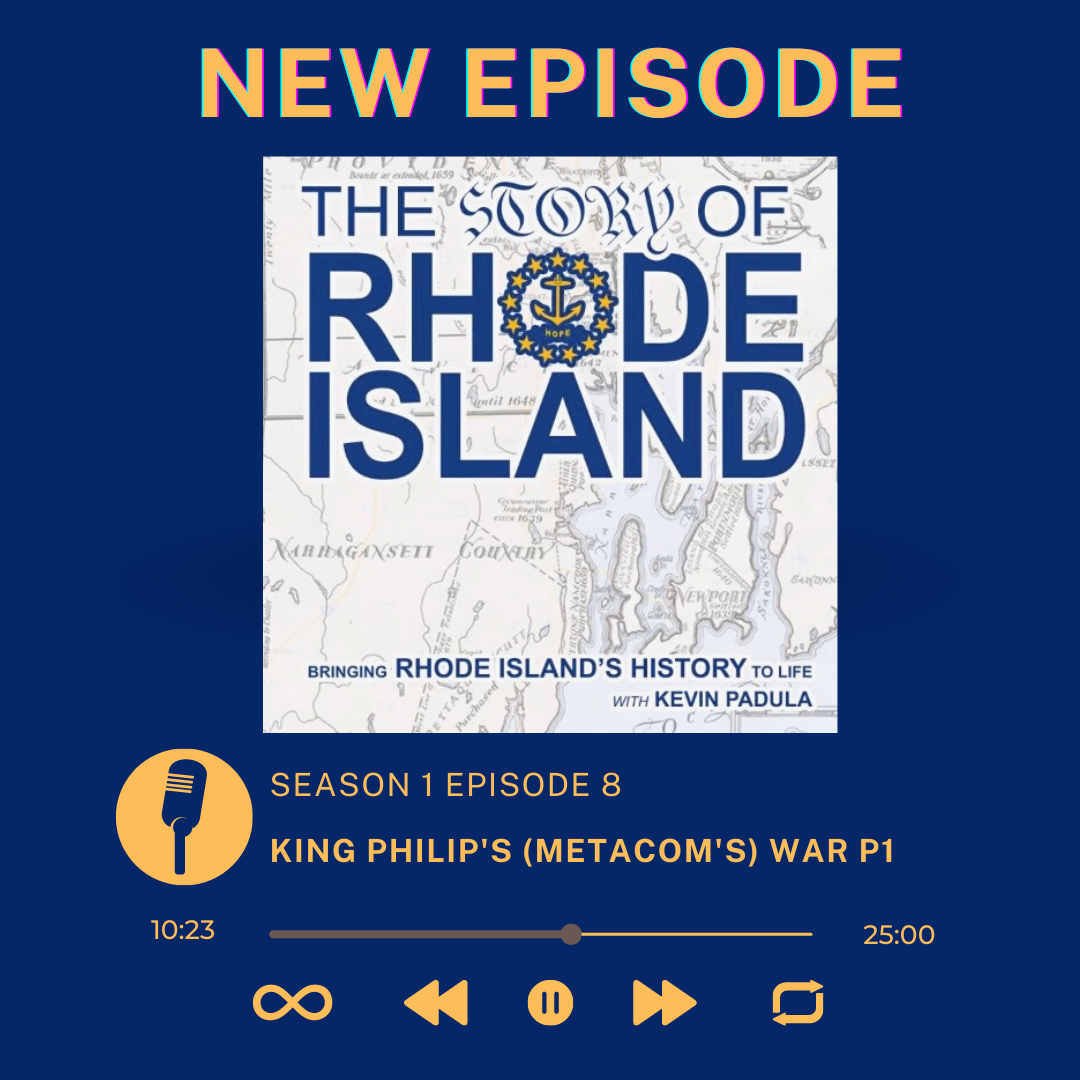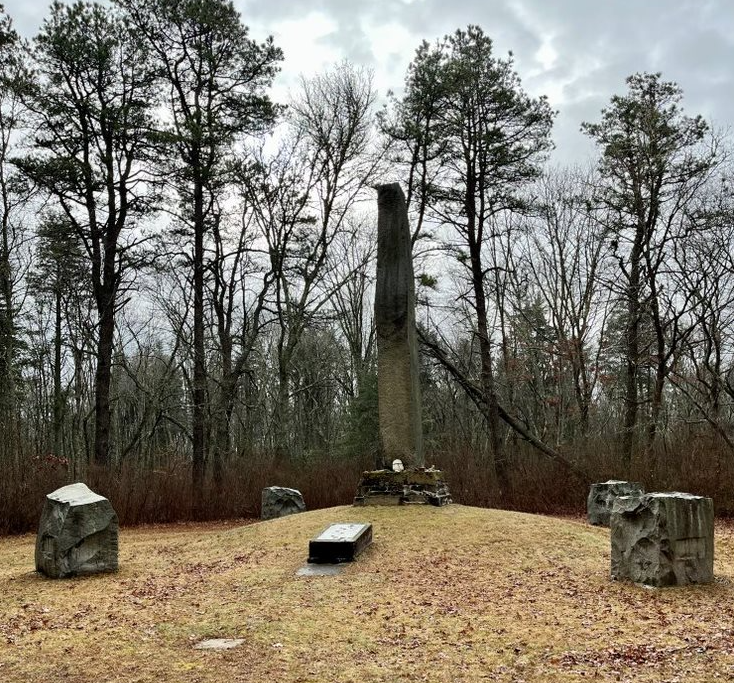After years of tension, a war between the English colonists and the tribes of southern New England breaks out and Rhode Island finds itself engulfed in this deadly conflict.
25 minutes | 1675 - 1676
Hear About:
📜The events that ignited a war between the English colonists and the tribes of New England
📜Initial raids and battles of King Philip's War in Bristol & Tiverton, Rhode Island, and southeastern Massachusetts.
📜When hundreds of Narragansett men, women, and children were murdered in southern Rhode Island during the Great Swamp Massacre

Benjamin Church
Known today as the "First American Ranger", Benjamin Church participated in key battles throughout King Philip's War and helped to end this deadly conflict by leveraging the native's military tactics that other Englishmen were hesitant to use.
Metacomet aka King Philip
Sachem of the Pokanoket Nation and the man who this deadly conflict is named after.
Canonchet
Sachem of the most powerful tribe in southern New England, the Narragansett Nation, and one of the war's greatest military tacticians.


Smith's Castle | North Kingstown, RI
In December 1675, a group of English soldiers met at Richard Smith's trading post just outside of Wickford village so that they could prepare to invade the Narragansett fort in present day South Kingstown. The battle that would take place at the Narragansett fort would end up being the biggest engagement in the entire war and eventually become known as "The Great Swamp Massacre". Although the English won the "battle" they failed to remove the Narragansett warriors from the war, leading them to begin raiding towns throughout Rhode Island shortly after. One of the buildings destroyed during the raid was Richard Smith's trading post. The building that stands there today, known as Smith's Castle, was built after the war.
.png)
Queen's Fort | Exeter, RI
In the woods of Exeter, Rhode Island, just off of Stony Lane, are the remnants of an old Narragansett Fort, known as Queen's Fort. English soldiers raided the fort in December of 1675, just days before attacking the Narragansetts in South Kingstown. Legend states that Queen Quaiapen was able to survive the attack by hiding in a secret underground chamber. To this day, people still visit Queen's Fort in search of the cave.

The Great Swamp Massacre Monument | South Kingstown, RI
Located deep in the woods of South Kingstown is a monument dedicated to the "Great Swamp Fight" which took place in December of 1675. Unfortunately, the "fight" turned into more of a massacre as hundreds of innocent Narragansett women and children were killed. The monument makes a couple of other incorrect claims as well. First, while it claims to be at the location where the Great Swamp Massacre took place, it's more likely not where the devastating event was located. Also, the plaque states the "Narragansett Indians made their last stand in King Philip's War" during this battle which couldn't be further from the truth. In fact, the Narragansett warriors would go on to lead a series of deadly raids throughout the Rhode Island countryside, destroying towns like Wickford, Warwick, and Providence.
.png)
Key Rhode Island Engagements of King Philip's War | 1675 - 1676
King Philip's War was extremely destructive to the Rhode Island Colony. From the summer of 1675 to Spring of 1676 hundreds of Native Americans & English were killed, hundreds of houses burnt to the ground, and many towns destroyed.
Timeline of Engagements:
- July 1675 - Almy's Pease Field Fight
- August 1675 - Nipsachuck Swamp Fight
- December 1676 - Two Narragansett villages destroyed, Jireh Bull Garrison destroyed, and hundreds of innocent Narragansetts are killed at the Great Swamp Massacre
- March 1676 - The towns of Wickford, Warwick, Pawtuxet, Providence, and Old Rehoboth (known as East Providence today) are destroyed. Then, over 50 English soldiers and several friendly natives are killed when Captain Pierce's men were ambushed in Central Falls, RI.
- August 1676 - King Philip is killed
Stonewall John - Architect of Queen's Fort
Known to the English as Stonewall John, this Narragansett man helped to build the fort known today as Queen's Fort in present day Exeter, RI. Since he was so well versed in English masonry some believed that he was actually an Englishman who took up arms with the Narragansetts but that is probably not true. It is more likely that he was a native man who worked for Richard Smith. After the Great Swamp Massacre, Stonewall John helped the Narragansett warriors raid the towns of Providence and Old Rehoboth (known as East Providence today).- Roger Williams and the Creation of the American Soul: Church, State, and the Birth of Liberty by John M. Barry
- God, War, and Providence: The Epic Struggle of Roger Williams and the Narragansett Indians Against the Puritans of New England by James A. Warren
- Colonial Rhode Island: A history by Sydney V. James
- Rhode Island's Founders: From Settlement to Statehood by Patrick T. Conley
- Changes in the Land: Indians, Colonists, and the Ecology of New England by William Cronon
- Manitou and Providence: Indians, Europeans, and the Making of New England, 1500-1643 by Neal Salisbury
- Rhode Island: A History by William G. McLoughlin
- King Philip's War: The History and Legacy of America's Forgotten Conflict by Eric B. Schultz & Michael J. Tougias
- The Skulking Way of War: Technology and Tactics Among the New England Indians by Patrick M. Malone
- The Entertaining History of King Philip's War by Benjamin Church and Thomas Church
- Queen’s Fort—Stone Refuge for Quaiapen, 1675-1676 by By Christian McBurney